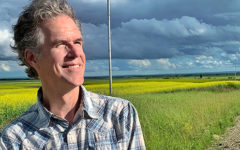
Ask Sonny Anything is a recurring feature where our readers pose questions to the great Sonny Osborne, one half of the iconic Osborne Brothers who redefined bluegrass music in the 1960s, and noted banjo maven and collector of fine prewar instruments. Everyone is encouraged to pose queries of your own each week in the comments, about his history in the music, his wealth of banjo knowledge, or regarding any life advice you might be needing.
Raymond Fairchild story. Cherokee, North Carolina. Norman Adams Bluegrass Festival at Happy Holiday Camp Grounds. About 1999 or 2000. Raymond and I are sitting at his record table talking, about everything, and nothing. Just sitting together. Two old codgers signing a few autographs, mainly doing nothing. We are all familiar with that breed of dog, I believe Russian Husky…but it’s the breed that has eyes so pale blue they are almost white. Well, this man walks up and begins talking to us and this guy, whom we both recognized and knew well enough that we were both joining in the short conversation. Well, after about 10 minutes he left and we were just sitting there….silent….almost uncomfortably silent. Raymond finally turned to me and said: “You know Hanny (Raymond’s interpretation of SONNY) YOU NEVER COULD TRUST A FELLER WITH THEM DAMNED ANIMAL EYES!” Tom T. Hall once wrote a song and Bobby and I were on the record. The song title was “That’s the world according to Raymond….” well, That’s Raymond. Rest well my friend.
S
Hi Sonny,
Thank you so much for writing this column, it is always the highlight of my week. I’m curious to know if you ever performed at the Carter Fold? Any memories of the Carter Family? Maybelle?
Clarence P.
HEY CLERANCE, Thank you for joining us. I appreciate it a lot. We never had the opportunity to play the Carter Fold and the reason was quite simple. They didn’t allow electric instruments and we had the electric bass. When we played The Paramount Theater in Bristol their representative approached me and asked if we would come to The Carter Fold and not bring the electric bass. I replied emphatically, NO! He didn’t say another word. Simple enough, I guess, although I could never understand how that would hinder the audience from liking us? Maybe, but no one else seemed to have a problem. Bill didn’t want us to bring our electric things to Bean Blossom and I seem to remember receiving more than A FEW STANDING OVATIONS WHEN WE FINALLY GET PERMISSION TO COME ANYHOW. The Carters, yes I knew Maybelle and her daughters. We did several dates with them. They were good. Anita had a beautiful voice and I loved Maybelle’s Guitar playing.
S
Sonny,
I hope you are well. Thanks for continuing to answer our many questions.
When I began to play banjo about 15 years ago, I listened almost exclusively to Earl, listening to his playing over and over, hearing new subtleties each time. I know I’m not unique in this. I found his playing to be very rich indeed. For so many of us players, Earl was our inspiration to begin picking. In fact I think the banjo is unique in that nearly without exception, anyone playing the instrument now was inspired to play after hearing Earl. Plus, unlike other instruments, there is nearly universal agreement about who the best player of the instrument has been.
I know that you too listened to Earl’s playing, over and over. My question for you is, what qualities in Earl’s playing do you think make it so special? We all try to sound like Earl and really never do, but it’s fun to continue to try. I think his playing has an elusive, intangible quality, hard to achieve. But for you, listening to him play, and you being one of the greatest players, what specifically would you say sets him apart? Any specific songs you’d point to as examples? Or, is it just a thing of beauty, a unique human expression, that can’t really be described in words?
Thanks!
Perry
Perry, thank you for your time. EARL. You are correct in your assessment of the effect he had on the banjo being accepted world wide, and those of us who were inspired by Earl. One record that drew us to his way of playing and sat him aside as a feller to be reckoned with! FOGGY MOUNTAIN BREAKDOWN. When he hit those beginning notes…5th, 3rd, 1st. G, G, D….School was out. I mean Git right on outa hyer!!!! Changed that style of music round the world forever.
Earl’s right hand did more than anyone had ever done before him, and in many cases that right hand has sent many to the showers. Yep…he was that good. And it was natural for Earl to do the things he was doing so it became our charge, as guys and girls who want to play the banjo, to be like Earl. Everything he did…even down to holding the banjo over the one (right) shoulder when it’s much more comfortable to put the strap around your neck, and I might add, much safer. But the one thing that put him in a category of one, was that right hand. So good…and it would do everything he asked of it. ‘twas a thing of beauty.
I can’t speak for the millions of others, but I studied him so hard, and carefully, every note so that my right hand would move naturally, and I, still, 53 years later, needed more practice. Yep…he was that good! You question me? Try doing the second break when he went to C7th on Roll In My Sweet Baby’s Arms with that backward roll and where most would slow down, it actually picked up speed. Or… WHEN HE WENT TO THE 5 CHORD DURING HIS SOLO ON CABIN IN CAROLINE…I repeat…HE WAS THAT DAMN GOOD! Because I’m convinced that was a mistake but he got into it and guess what got him out of it well enough that we struggled to learn it. THAT AUTOMATIC RIGHT HAND. HE WAS BETTER THAN GOOD!
S
Sonny,
Last week you responded to Bob Dylan’s comment about the Osborne Brothers in the NYT. Outside of bluegrass, what artists did you listen to on a regular basis and/or draw inspiration in your playing from? And do you think listening to other genres will ultimately make a bluegrass musician — or any musician for that matter, better at their craft?
Will H.
Will. Thank you. Great question. Buddy Emmons, Hargis Robinson, Grady Martin, Earl Scruggs, Rudy Lyle, Marvin Gay, Eric Clapton, Merle Travis, Roy Nichols, the list goes on. I believe if a person locks in one instrument, loves it, studies it, can’t get enough of that one thing, he is more apt to make a better musician. That doesn’t mean one can’t listen to other genres. Listening to it all, everyone who is pleasing to your ear and gather knowledge from them, pick up a lick here and there, phrasing from others, approach to their instrument, and everything you can learn. YOU NEVER STOP LEARNING. A great musician is made through hard, focused, everyday practice. Yep…PRACTICE PRACTICE PRACTICE…I CAN’T SAY IT ENOUGH. AND YOU CAN’T DO IT ENOUGH NOR CAN YOU OVERDO IT…..!
S
Sonny,
How well did you know Dixie Hall? She was such an incredible person who contributed so greatly to bluegrass music, especially to women in bluegrass. I’m wondering if you have any recollections you might be willing to share?
Molly W.
Molly….I knew Dixie slightly…in passing, but first name basis. This was when she was secretary for Flatt and Scruggs. And then maybe only several times. After she and Tom married I doubt that I saw Dixie again more than once or twice. When I met her, and all of the several times, I believe this occurred before her talent emerged. Tom was such a great talent that I would imagine she learned and drew from him. In fact, I would make a pretty good wager that he taught her the in’s and out’s of the business, and song writing. My opinion, Tom T. Hall was one of the most talented song writers to walk on this planet…especially for COUNTRY Folk!
s
If you have something you would like to ask Sonny, be sure to post it in the comments below, or send it to us directly.







